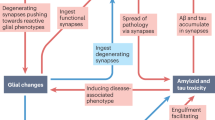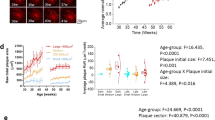Abstract
Plasticity of the synaptic contact zone was previously observed following loss of synapses in the cerebral cortex of normal aging humans. The present study was undertaken to determine if there was quantitative evidence of synapse loss and synapse plasticity in the inferior temporal, superior parietal, parieto-occipital, and superior frontal cortical regions in Alzheimer's disease (AD), and how such changes related to the neurofibrillary tangles and amyloid plaques. The results showed that age at autopsy did not correlate with the numbers of synapses, plaques, or tangles. However, the numbers of synapses strongly reflected the pathology of AD; in all four brain regions, there were fewer synapses as the numbers of plaques and tangles increased. In the synaptic temporal and superior parietal cortices, the loss of synapses was accompanied by an increase in the synaptic contact length. The results suggest that, in some cerebral cortical brain regions, synapses are capable of plasticity changes, even when the pathology of AD and loss of synapses are severe.
Similar content being viewed by others
References
Adams I. (1987a) Comparison of synaptic changes in the precentral and postcentral cerebral cortex of aging humans: a quantitative ultrastructural study.Neurobiol. Aging 8, 203–212.
Adams I. (1987b) Plasticity of the synaptic contact zone following loss of synapses in the cerebral cortex of aging humans.Brain Res. 424, 343–351.
Adams I. and Jones D. G. (1982) Synaptic remodelling and astrocytic hypertrophy in rat cerebral cortex from early to late adulthood.Neurobiol. Aging 3, 179–186.
Adams I. and Jones D. J. (1987) Effects of normal and pathological aging on brain morphology: neurons and synapses.Current Topics in Research on Synapses, vol. 4, Jones D. J., ed., Liss, NY, pp. 1–84.
Beyreuther K. and Masters C. (1991) Amyloid βA4 protein deposition and the cause of Alzheimer's disease.J. Neurochem. 57 (suppl.), S3.
Bjorklund A. and Stenevi U. (1979) Regeneration of monoaminergic and cholinergic neurons in the mammalian central nervous system.Physiol. Rev. 49, 62–100.
Butcher L. L. and Woolf N. J. (1989) Neurotrophic agents exacerbate the pathologic cascade of Alzheimer's disease.Neurobiol. Aging 10, 557–570.
Davies C. A., Mann D. M. A., Sumpter P. Q., and Yates P. O. (1987) A quantitative morphometric analysis of the neuronal and synaptic content of the frontal and temporal cortex in patients with Alzheimer's disease.J. Neurol. Sci. 78, 151–164.
Davies L., Wolska B., Hilbich, C., Multhaup G., Martins R., Simms M., Beyreuther K., and Masters C. (1988) A4 amyloid protein deposition and the diagnosis of Alzheimer's disease.Neurology 38, 1688–1693.
Flood D. G. and Coleman P. D. (1990) Hippocampal plasticity in normal aging and decreased plasticity in Alzheimer's disease.Prog. Brain Res. 83, 435–442.
Geinisman Y., Morrell F., and DeToledo-Morrell L. (1988) Remodeling of synaptic architecture during hippocampal “kindling,”Proc. Natl. Acad. Sci. USA 85, 3260–3264.
Gibson P. H. (1983) EM study of the numbers of cortical synapses in the brains of aging people and people with Alzheimer-type dementia.Acta Neuropathol. (Berl.) 62, 127–133.
Goldowitz D., Scheff S. W., and Cotan C. W. (1979) The specificity of reactive synaptognesis: a comparative study in the adult rat hippocampal formation.Brain Res. 170, 427–441.
Hannay H. and Levin H. (1987) Recovery of function.National Forum, The Phi Kappa Phi Journal. Spring (1987), 7.
Hansen L. A., DeTeresa R., Davies P., and Terry R. D. (1988) Neocortial morphometry, lesion counts, and choline acetyltransferase levels in the age spectrum of Alzheimer's disease.Neurology 38, 48–54.
Ihara Y. (1988) Massive somatodendritic sprouting of cortical neurons in Alzheimer's disease.Brain Res. 459, 138–144.
Ihara Y. (1991) The regenerative process of Alzheimer's disease.J. Neurochem. 57 (suppl.), S3.
Jorm A. F. (1985) Subtypes of Alzheimer's dementia: a conceptual analysis and critical review.Psychol. Med. 15, 543–553.
Khachaturian Z. S. (1985) Diagnosis of Alzheimer's disease.Arch. Neurol. 42, 1097–1105.
Lewis D. A., Higgins G. A., Young W. G., Goldgaber D., Gajdusek D. C., Wilson M. C., and Morrison J. H. (1988) Distribution of precursor amyloid-β-protein messenger RNA in human cerebral cortex: Relationship to neurofibrillary tangles and neuritic plaques.Proc. Natl. Acad. Sci. USA 85, 1691–1695.
Masters C. and Beyreuther R. (1988) Amyloidogenic A4 subunit: clues to the pathogenesis of the neurofibrillary tangle, Alzheimer plaque, and congophilic angiopathy.Aging and the Brain, Terry R. D., ed., Raven, NY, pp. 183–203.
Pasternack J., Estus S., Palmert M., Usiak M., Cheung T. and Younkin S. (1991) Amyloid precursor processing in Alzheimer's disease.J. Neurochem. 57 (suppl.), S3.
Paula-Barosa M. M., Saraiva A., Tavares M. A., Borges M. M., and Verwer R. W. H. (1986) Alzheimer's disease: maintenance of neuronal and synaptic densities in frontal cortical lay-ers 2 and 3.Acta Neurol. Scand. 74, 404–408.
Phelps C. H. (1990) Neural plasticity in aging and Alzheimer's disease: some selected comments.Prog. Brain Res. 86, 3–9.
Scheff S. W., DeKosky S. T., and Price D. A. (1990) Quantitative assessment of cortical synaptic density in Alzheimer's disease.Neurobiol. Aging 11, 29–37.
Terry R. D. and Hansen L. A. (1988) Some morphometric aspects of Alzheimer's disease and of normal aging.Aging and the Brain. Terry R. D., ed., Raven, NY, pp. 109–114.
Uchida Y., Ihara Y., and Tomonoga M. (1988) Alzheimer's disease brain extracts stimulate the survival of cerebral cortical neurons from neonatal rats.Biochem. Biophys. Res. Commun. 150, 1263–1267.
Whitson J. S., Selkoe D. J., and Cotman C. W. (1989) Amyloid beta protein enhances the survival of hippocampal neurons in vitro.Science 243, 1488–1490.
Author information
Authors and Affiliations
Rights and permissions
About this article
Cite this article
Adams, I.M. Structural plasticity of synapses in Alzheimer's disease. Mol Neurobiol 5, 411–419 (1991). https://doi.org/10.1007/BF02935562
Issue Date:
DOI: https://doi.org/10.1007/BF02935562




